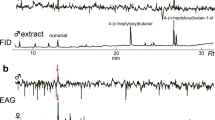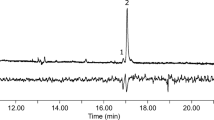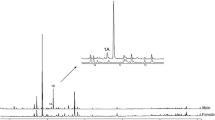Abstract
A synthetic mixture of nine green leaf volatiles (GLVs) including linalool was tested on antennae of Ips typographus (L.) with coupled gas chromatographic–electroantennographic detection (GC-EAD). Strong responses were found to 1-hexanol, (Z)-3-hexen-1-ol, and (E)-2-hexen-1-ol. Weak responses were recorded to (E)-3-hexen-1-ol, (Z)-2-hexen-1-ol and linalool, while hexanal, (E)-2-hexenal and (E)-3-hexenyl acetate elicited no EAD responses. In a laboratory walking bioassay, the attraction of I. typographus females to a synthetic pheromone source was significantly reduced when a mixture of the three most EAD-active GLV alcohols was added to the source. Further reduction in response was obtained when these three alcohols were combined with verbenone (Vn). In field trapping experiments, a blend of 1-hexanol, (Z)-3-hexen-1-ol, and (E)-2-hexen-1-ol reduced I. typographus trap catches by 85%, while ca. 70% reduction of trap catch was achieved by Vn or a blend of (E)-3-hexen-1-ol, (Z)-2-hexen-1-ol, and linalool. The strongest disruptive effect was found when Vn plus a blend of the three most EAD active GLV alcohols was added to the pheromone trap (95% catch reduction). Adding the blend of the three most EAD active alcohols to pheromone-baited traps significantly reduced the proportion of males captured. These three GLV alcohols were also disruptive in the laboratory and in the field when tested individually. Hexanal, (E)-2-hexenal, and (Z)-3-hexenyl acetate were inactive both in the lab and in the field. Our results suggest that these nonhost green leaf alcohols may explain part of the host selection behavior of conifer-attacking bark beetles and may offer a source of inhibitory signals for alternative management strategy for forest protection.
Similar content being viewed by others
REFERENCES
Atkins, M. D. 1966. Behavioral variation among scolytids in relation to their habitat. Can. Entomol. 98:285–288.
Bakke, A. 1981. Inhibition of the response in Ips typographus to the aggregation pheromone: Field evaluation of verbenone and ipsenol. J. Appl. Entomol. 92:172–177.
Borden, J. H. 1985. Aggregation pheromones, pp. 257–285, in G. A. Kerkurt and L. I. Gilbert (eds.). Comprehensive Insect Physiology, Biochemistry and Pharmacology, Vol. 9. Pergamon Press, Oxford.
Borden, J. H. 1996. Disruption of semiochemical-mediated aggregation in bark beetles, pp. 421–438, in R. T. Cardé, and A. K. Minks, (eds.). Pheromone Research: New Directions. Chapman and Hall, New York.
Borden, J. H., Chong, L. J., Savoie, A., and Wilson, I. M. 1997. Responses to green leaf volatiles in two biogeoclimatic zones by striped ambrosia beetle, Trypodendron lineatum. J. Chem. Ecol. 23:2379–2491.
Borden, J. H., Wilson, I. M., Gries, R., Chong, L. J., Pierce, H. D., Jr., and Gries, G. 1998. Volatiles from the bark of trembling aspen, Populus tremuloides Michx. (Salicaceae) disrupt secondary attraction by the mountain pine beetle (Dendroctonus ponderosae Hopkins (Coleoptera: Scolytidae). Chemoecology 8:69–75.
Borg-Karson, A.-K., Eidmann, H. H., LindstrÖm, M., Norin, T., and Wiersma, N. 1985. Odoriferous compounds from the flowers of the conifers Picea abies, Pinus sylvetris and Larix sibirica. Phytochemistry 24:455–456.
Byers, J. A. 1991. BASIC algorithms for random sampling and treatment randomization. Comput. Biol. Med. 21:69–77.
Byers, J. A., and Wood, D. L. 1980. Interspecific inhibition of the response of the bark beetles, Dendroctonus brevicomis and Ips paraconfusus, to their pheromones in the field. J. Chem. Ecol. 6:149–164.
Byers, J. A., and Wood, D. L. 1981. Interspecific effects of pheromones and the attraction of bark beetles Dendroctonus brevicomis and Ips paraconfusus in the laboratory. J. Chem. Ecol. 7:9–18.
Byers, J. A., Zhang, Q.-H., Schlyter, F., and Birgersson, B. 1998. Volatiles from non-host birch trees inhibit pheromone response in spruce bark beetles. Naturwissenschaften 85:557–561.
Deglow, E. K., and Borden, J. H. 1998a. Green leaf volatiles disrupt and enhance response to aggregation pheromones by the ambrosia beetle, Gnathotrichus sulcatus (LeConte) (Coleoptera: Scolytidae). Can. J. For. Res. 28:1697–1705.
Deglow, E. K., and Borden, J. H. 1998b. Green leaf volatiles disrupt and enhance response by the ambrosia beetle, Gnathotrichus retusus (LeConte) (Coleoptera: Scolytidae) to pheromonebaited traps. J. Entomol. Soc. B.C. 95:9–15.
Dickens, J. C., Billings, R. F., and Payne, T. L. 1991. Green leaf volatiles: A ubiquitous chemical signal modifies insect pheromone responses, pp. 277–280, in I. Hrdy (ed.). Insect Chemical Ecology. Acadamia Praha, Prague.
Dickens, J. C., Billings, R. F., and Payne, T. L. 1992. Green leaf volatiles interrupt aggregation pheromone response in bark beetles infecting pines. Experientia 48:523–524.
Gilbert, B. L., and Norris, D. M. 1968. A chemical basis for bark beetle (Scolytus) distinction between host and nonhost trees. J. Insect Physiol. 14:1063–1068.
Guerrero, A., Feixas, J., Pajares, J., Wadhams, L. J., Pickett, J. A., and Woodcock, C. M. 1997. Semiochemically induced inhibition of behaviour of Tomicus destruens (Woll.) (Coleoptera: Scolytidae). Naturwissenschaften 84:155–157.
Huber, D. P. W., Gries, R., Borden, J. H., and Pierce, H. D., Jr. 1999. Two pheromones of coniferophagous bark beetles found in the bark of nonhost angiosperms. J. Chem. Ecol. 25:805–816.
LindelÖw, Å., and Weslien, J. 1986. Sex-specific emergence of Ips typographus L. (Coleoptera: Scolytidae) and flight behavior in response to pheromone sources following hibernation. Can. Entomol. 118:59–67.
Nijholt, W. W., and SchÖnherr, J. 1976. Chemical behaviour of scolytids in West Germany and western Canada. Can. For. Serv. Bi-Month. Res. Notes 32:31–32.
Poland, T. M., and Haack, R. A. 2000. Pine shoot beetle, Tomicus piniperda (Coleoptera: Scolytidae), responses to common green leaf volatiles. J. Appl. Entomol. In press.
Poland, T. M., Borden, J. H., Stock, A. J., and Chong, L. J. 1998. Green leaf volatiles disrupt responses by the spruce beetle, Dendroctonus rufipennis, and the western pine beetle, Dendroctonus brevicomis (Coleoptera: Scolytidae) to attractant-baited traps. J. Entomol. Soc. B.C. 95:17–24.
Schlyter, F., and Anderbrant, O. 1993. Competition and niche separation between two bark beetles: Existence and mechanisms. Oikos 68:437–447.
Schlyter, F., and Birgersson, G. 1999. Forest Beetles, pp. 113–148, in R. J. Hardie and A. K. Minks (eds.), Pheromones of Non-Lepidopteran Insects Associated with Agricultural Plants. CAB International, Wallingford, U.K.
Schlyter, F., and Cederhom, I. 1981. Separation of the sexes of living spruce bark beetle, Ips typographus (L.) (Coleoptera: Scolytidae). J. Appl. Entomol. 92:42–47.
Schlyter, F., LeufvÉn, A., and Birgersson, G. 1989. Inhibition of attraction to aggregation pheromone by verbenone and ipsenol: Density regulation mechanisms in bark beetle Ips typographus. J. Chem. Ecol. 15:2263–2277.
Schlyter, F., LÖfqvist, J., and Jakus, R. 1995. Green leaf volatiles and verbenone modify attraction of European Tomicus, Hylurgops, and Ips bark beetles, pp. 29–44, in F. P. Hain, S. M. Salom, W. F. Ravlin, T. L. Payne, and K. F. Raffa (eds.). Behavior, Population Dynamics, and Control of Forest Insects, Proceedings of a Joint IUFRO Working Party Conference-February 1994, Ohio State University. OARDC, Wooster, Ohio.
Schroeder, L. M. 1992. Olfactory recognization of nonhosts aspen and birch by conifer bark beetles Tomicus piniperda and Hylurgops palliatus. J. Chem. Ecol. 18:1583–1593.
Schroeder, L. M., and LindelÖw, Å. 1989. Attraction of scolytids and associated beetles by different absolute amounts and proportions of α-pinene and ethanol. J. Chem. Ecol. 15:807–817.
TØmmerÅs, B. Å. 1989. Host selection by odourous compounds from host and non-host trees in bark beetles. Fauna Norv. Ser. B 36:75–79.
TØmmerÅs, B. Å., and Mustaparta, H. 1989. Single cell responses to pheromones, host and non-host volatiles in the ambrosia beetle Trypodendron lineatum. Entomol. Exp. Appl. 52:141–148.
Visser, J. H. 1986. Host odor perception in phytophagous insects. Annu. Rev. Entomol. 31:121–144.
Whitman, D. W., and Eller, F. J. 1990. Parasitic wasps orient to green leaf volatiles. Chemoecology 1:69–75.
Wilson, I. M., Borden, J. H., Gries, R., and Gries, G. 1996. Green leaf volatiles as antiaggregants for the mountain pine beetle, Dendroctonus ponderosae Hopkins (Coleoptera: Scolytidae). J. Chem. Ecol. 22:1861–1875.
Zhang, Q.-H., Birgersson, G., Zhu, J.-W., LÖfstedt, C., LÖfqvist, J., and Schlyter, F. 1999. Leaf volatiles from nonhost deciduous trees: variation by tree species, season, and temperature and electrophysiological activity in Ips typographus. J. Chem. Ecol. 25:1923–1943.
Zhang, Q.-H., Schlyter, F., and Birgersson, G. 2000. Bark volatiles from non-host angiosperm trees of spruce bark beetle, Ips typographus (L.) (Coleoptera: Scolytidae): Chemical and electrophysiological analysis. Chemoecol. In press.
Author information
Authors and Affiliations
Rights and permissions
About this article
Cite this article
Zhang, QH., Schlyter, F. & Anderson, P. Green Leaf Volatiles Interrupt Pheromone Response of Spruce Bark Beetle, Ips typographus . J Chem Ecol 25, 2847–2861 (1999). https://doi.org/10.1023/A:1020816011131
Issue Date:
DOI: https://doi.org/10.1023/A:1020816011131




